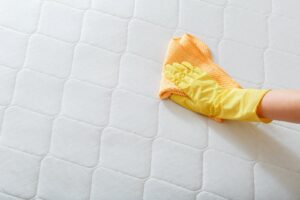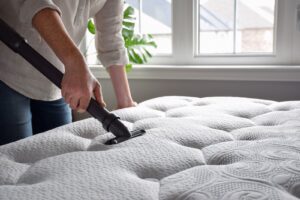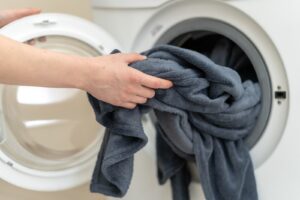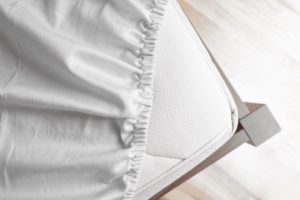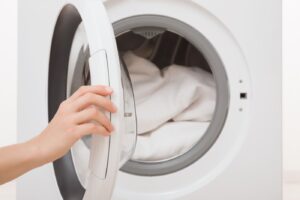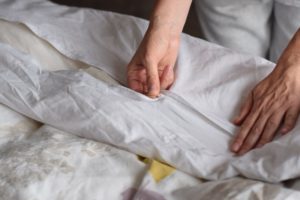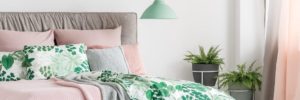What Is Tencel Fabric?
Tencel is a brand name for a few types of sustainable fabric made from wood pulp. A high-end material, it is well regarded for being soft and durable and is a popular alternative to cotton for cooling bed sheets. Care instructions for Tencel should be followed carefully, generally avoiding high heat.
Trademarked by Lenzing, an Austrian chemical and textile manufacturing company, Tencel is the name of a group of semi-synthetic textiles made from sustainably sourced wood pulp that is then chemically processed into thread.
Considered a somewhat high-end fabric, Tencel is known for its soft feel and durability. It is also noted for both its breathability and moisture-wicking properties, which make it an exceptional fabric for temperature regulation.
Table of Contents
What Is Tencel?
Tencel is made from several types of wood pulp, though it’s most commonly sourced from eucalyptus trees. The wood pulp is chemically processed into a semi-synthetic cellulose fiber that’s used in an array of products like clothing and bedding. The manufacturing process is monitored to ensure sustainable wood sourcing, and Tencel production typically uses less water and fewer pesticides than cotton.
Tencel is an exceptionally soft fabric that’s hypoallergenic and well suited for sensitive skin. It is also quite durable and resists pilling. Tencel sheet sets and pajamas are also highly regarded for being breathable and moisture-wicking.
Types of Tencel
Tencel is manufactured in one of two main versions: lyocell and modal. It is also sometimes blended with other materials such as cotton and polyester to balance the characteristics of the different materials.
Tencel Lyocell
This is the latest generation of rayon, which replaces toxic manufacturing chemicals with a nontoxic solvent. The manufacturing process recaptures 99% of the solvent to use again, making lyocell a more sustainable material. It is primarily made using sustainably grown eucalyptus wood. It is a common choice for Tencel sheet sets.
Tencel Modal
Modal is an update to ordinary rayon that gives the material better strength when wet, even when woven into lightweight fabrics. It is primarily made from beech wood. Notably, the manufacturing process uses a harsher chemical than lyocell, but the resulting fabric is more likely to be machine-washable and shrink-resistant.
Tencel Blends
Tencel threads are often blended with other materials such as cotton or polyester to help balance the characteristics of the different materials in a single fabric. Because Tencel can be somewhat expensive, blends can be used to achieve a lower overall price-point.
Tencel vs. Cotton
Consumers researching sleep products often consider both Tencel and cotton sheets or pajamas due to their similar traits. Both materials start out from natural plant fibers, although Tencel requires less water and pesticide use. Both are durable, breathable, and moisture-wicking materials, although Tencel has an overall edge in temperature regulation.
Most Tencel sheets use a sateen weave. This one-under, three- or four-over thread pattern lends products a subtle sheen and smooth feel. While some cotton sheets are also woven using the sateen method, other cotton weaves and knits include percale, twill, and jersey, which have different performance characteristics.
Cotton is generally easy to care for, while Tencel typically cannot be washed or dried at high temperatures. Tencel is generally priced somewhere between ordinary cotton products and those made from luxury Egyptian cotton.
Tencel vs. Rayon
Rayon is a category of fibers that use cellulose (typically from wood pulp) which is chemically processed into a semi-synthetic material. Invented in France in the 1890s, it was the first manufactured semi-synthetic fiber. Tencel lyocell and Tencel modal are both varieties of rayon. Lyocell is the most environmentally friendly variation of rayon.
Advantages of Tencel Fabric
Tencel is a versatile fabric that’s popular in both clothing and bedding products. It has both performance and environmental benefits that may appeal to certain consumers.
Performance Benefits
When deciding whether to choose Tencel for products like bedding or pajamas, factors like the fabric’s comfort, durability, temperature regulation, and ease of care may affect your decision.
Comfort
Those who prefer a soft texture to their fabrics may find Tencel to be among the most comfortable textiles. People who sleep hot or experience night sweats may particularly appreciate the temperature-regulating properties of Tencel.
Durability
Tencel products are quite durable and are less prone to pilling when compared with cotton. However, that durability is contingent on following the care instructions. Avoid the application of high heat to the material for best results and note that some Tencel lyocell products may require dry-cleaning only.
Breathability
Tencel is a naturally breathable and moisture-wicking material. These features make it a good choice for hot sleepers seeking cooling sheets or pajamas.
Ease of Care
Tencel modal is typically machine-washable, but be sure to follow the care instructions on the product’s label. Some Tencel lyocell products are dry-clean only. In general, avoid the use of high heat in the washer and dryer for Tencel products that can be machine-laundered.
Environmental Benefits
Tencel is made from sustainably sourced renewable wood products, which typically require less pesticide use and water compared with growing cotton. Due to the nontoxic chemical processing and recycling used for making Tencel lyocell, it is often seen as a particularly sustainable material.
Eco-conscious consumers may want to consider if the product has been treated with harsh dyes. Options made with botanical dyes are available for some Tencel products.
How to Care For Tencel Fabric
Tencel is generally a long-lasting fabric that naturally avoids wrinkling and can be cared for using ordinary cleaning methods. However, a small proportion of Tencel products are dry-clean only.
For best results, follow the instructions on the care label for any Tencel product. Many Tencel products can be machine-washed in cold or warm water on a gentle or delicate cycle. Higher temperatures can damage the material, so it is generally not recommended to dry them on high heat.

Still have questions? Ask our community!
Join our Sleep Care Community — a trusted hub of sleep health professionals, product specialists, and people just like you. Whether you need expert sleep advice for your insomnia or you’re searching for the perfect mattress, we’ve got you covered. Get personalized guidance from the experts who know sleep best.

